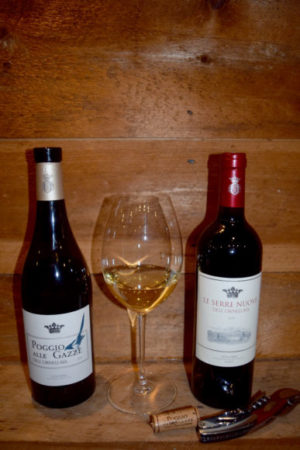Super Tuscan vintages at bargain prices

The last time I was in Tuscany was about six years ago on a media trip to explore the wines from the west coast of this Italian region near the Tyrrhenian Sea. Maremma and Montecucco are two Tuscan subregions experiencing major infusions of interest and money. As the price of vineyard land in central Tuscany exploded, other nearby regions became more attractive. Many of the new vineyards and some existing established wine estates that have been producing wine for generations now are owned by some of the titled and royal names of Italy. Antinori and Frescaboldi are two such names that have wine and other holdings throughout Italy and have been making wine for many generations. Frescobaldi”™s wine production stretches back 700-plus years to the year 1308 and Antinori”™s wine emergence happened 636 years ago in 1385.
Throughout Italy there exists a qualitative wine-ranking system. Denominazione di Origine Controllata e Garantita (DOCG) is the highest designation for Italian wines, while the Denominazione di Origine Controllata (DOC) is slightly more relaxed. These two classifications require strict adherence to grapes allowed and oak aging and bottle release times among other things, and both require a wine-jury tasting before the label is affixed to the bottle. On the label is a specific number and a QR code so the curious consumer can learn virtually everything about the wine. But these restrictive measures in place didn”™t work with some producers who wanted to grow grapes not allowed by these standards. Sassicaia began to plant some Bordeaux noble varieties Cabernet Sauvignon, Merlot, Cabernet Franc and Verdot in the 1960s. Thus was born the Super Tuscan unofficial designation.
Within the region of Maremma in and around the city of Bolgheri along the western coastline several other Super Tuscan producers are now fully established and making some wonderful wines. Solaia, Ornellaia, Tignanello, Messorio and Tua Rita Redigaffi are a few of the wines that have bucked the system and the prices they command are proof of their excellence. I recently received a package containing a red and a white wine from Ornellaia. Le Serre Nuove Dell”™ Ornellaia is known as the vineyard”™s second label, “Made with the same passion and attention to detail” as the flagship brand Ornellaia. It showed flavors of dark fruit, blackberry and dark cherry with balsamic presence and a velvety texture. The wine was layered with pleasant tannins for mouthfeel and presented great spicy aromatics. The white wine, Poggio Alle Gazze Dell”™Ornellaia, also from 2019, exhibits Sauvignon Blanc dominant flavors accented with Vermentino and Verdicchio, showing crisp, fresh citrus, puckery lemon and finely ground white pepper. Both are delicious, worthy discoveries.
The top labels for these Super Tuscan producers will typically cost you $200 to $300 per bottle. This obviously is a special occasion wine for most of us. But each of these producers also make other labels, often from the same or adjacent vineyards, made by the same winemaker with all the winery”™s tanks, barrels and staff. In good vintage years, these second- and third-label wines can be found for a fraction of the first-label cost, sometimes with little or no discernable difference between the tiers. In lesser vintage years, most of the best quality grapes will be employed in the first label. But in regional banner vintages, it is possible to buy the second labels for $50 to $60 per bottle. Each of the wines I tasted here have a suggested retail price of $82. But I found each online for considerably less. For those vintage years, find a well-stocked store like The Wine Connection in Pound Ridge, Total Wines in Norwalk or Zachys in Scarsdale that offers case discounts, and you can be essentially savoring a $250 bottle for $50 or $60. That”™s smart shopping and will put a smile on your face ”” guaranteed.
Write me at doug@dougpaulding.com.